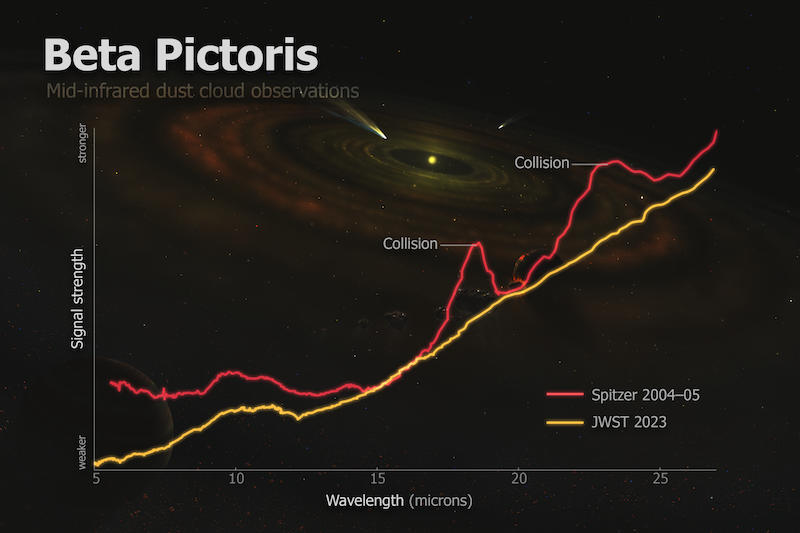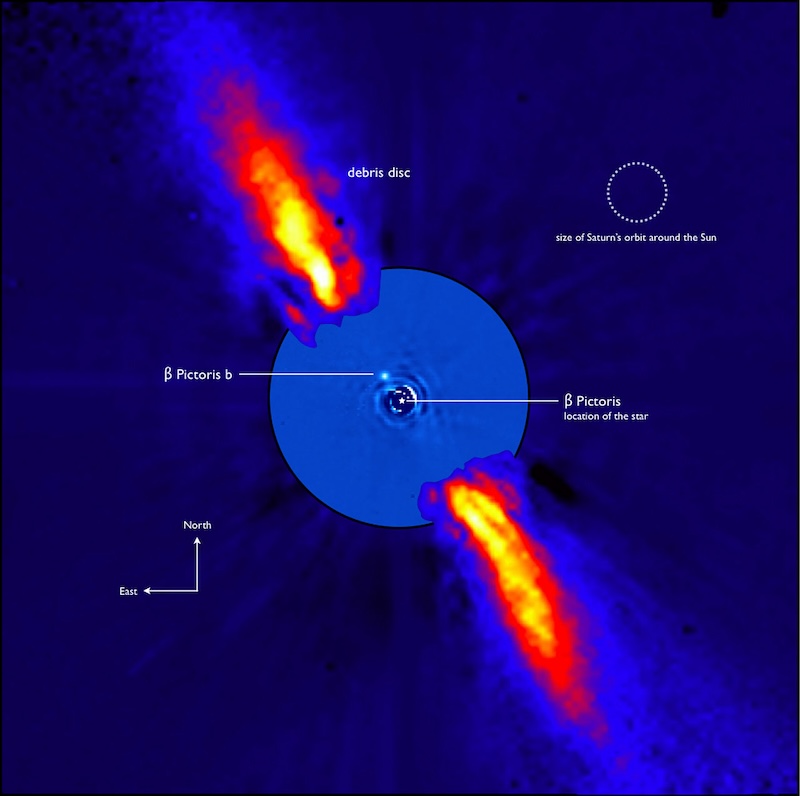- The Beta Pictoris system is young, only about 20 million years old. It’s young enough to be in the process of forming planets. It has at least two gas giant planets and smaller rocky planets possibly starting to form as well.
- Planets form from a swirling cloud of gas, dust, and rocky debris. In this cloud are many collisions, and collisions are part of the process that makes planets.
- Astronomers now see evidence for a massive asteroid collision in the Beta Pictoris star system.
Asteroid collision in young star system
Asteroids are chunks of material remaining from the vast and violent process of collisions that took place in our early solar system. In our solar system, 4.5 billion years ago, planets are thought to have formed from a vast cloud in space surrounding our young sun. And the latter part of the planet-forming process involved collisions between asteroids. We know some of the larger young asteroids collided to form even-bigger ones. Could some asteroid collisions have led to bodies large enough to develop enough self-gravity to become round planets? Now we have a chance to study that possibility. A team of researchers, led by Johns Hopkins University, said on June 10, 2024, that they’ve found evidence for a giant asteroid collision in the Beta Pictoris star system, only 63 light-years away.
The Beta Pictoris system is fascinating to astronomers. It’s nearby and can provide evidence of theories of solar system formation that have been around since at least the mid-20th century. Beta Pictoris is seen by powerful telescopes to be surrounded by a disk of debris. At least two gas giant planets are known to be forming in this protoplanetary disk. Lead author Christine Chen, an astronomer at Johns Hopkins University, said:
Beta Pictoris is at an age when planet formation in the terrestrial planet zone [the zone where rocky planets form] is still ongoing through giant asteroid collisions. So what we could be seeing here is basically how rocky planets and other bodies are forming in real time.
The “real-time” aspect of this discovery is really exciting. In the reckoning of earthly astronomers, the giant asterid collision they observed happened only 20 years ago (that’s 20 years, plus the 63 years the light had to travel to reach our eyes). Real time indeed for any astronomical discovery, where timescales typically measure in the millions or billions of years.
Beta Pictoris is young
The Beta Pictoris system is much younger than our solar system. It’s about only 20 million years old. It’s like a baby compared with our solar system, which is 4.5 billion years old. And the giant asteroid collision – just observed – is thought to have taken place just 20 years ago (plus 63 years of light-travel time).
The team used new data from the Webb space telescope which was then combined with older data from the Spitzer space telescope to make their discovery. They presented their findings at the 244th Meeting of the American Astronomical Society in Madison, Wisconsin, on June 13, 2024.
The abstract of the presentation is available here.

Clues about how planetary systems evolve
Our solar system has two basic kinds of objects we call planets. Some are large gas giants such as Jupiter and Saturn. And some are smaller rocky worlds such as Earth and Mars. Beta Pictoris has two known gas giant planets, Beta Pictoris b and Beta Pictoris c. Beta Pictoris b was discovered in 2008 and Beta Pictoris c in 2020.
Remember that the star Beta Pictoris is only 20 million years old. So these big planets, Beta Pictoris b and c, are not unexpected. These big gas worlds would be expected to form first in a fledgling solar system.
Meanwhile, at just 20 million years, any rocky planets would likely still be in the process of forming. And asteroid collisions should be part of this process. This makes Beta Pictoris an ideal system to study for clues about how planetary systems evolve in general, and about how rocky worlds, such as our own Earth, might have come to be. Being relatively close by at 63 light-years helps, too. It means astronomers can study the random processes involved, such as asteroid collisions and space weathering. Co-author Kadin Worthen, a doctoral student in astrophysics at Johns Hopkins University, said:
The question we are trying to contextualize is whether this whole process of terrestrial and giant planet formation is common or rare, and the even more basic question: Are planetary systems like the solar system that rare? We’re basically trying to understand how weird or average we are.
Data from Webb and Spitzer
The researchers made the discovery by combining new data from Webb and old data from Spitzer from 2004 and 2005. Spitzer had previously identified dust particles around the young star. Subsequently, Webb tracked the composition and size of particles in the same region. Webb’s observations, however, revealed significant energy changes in the particles.
This meant that these weren’t the same particles – crystalline silicates – that Spitzer saw. But why? The researchers said that there were collisions among asteroids as recently as 20 years ago. The newer particles are now much smaller, smaller than pollen or powdered sugar. Those collisions created all the new dust. Chen explained:
We think all that dust is what we saw initially in the Spitzer data from 2004 and 2005. With Webb’s new data, the best explanation we have is that, in fact, we witnessed the aftermath of an infrequent, cataclysmic event between large asteroid-size bodies, marking a complete change in our understanding of this star system.
The results also suggest that dust originally pushed outward from the star by radiation is no longer detectable. That dust, once heated by the radiation and making it easier to detect, has now cooled off. And contrary to previous assumptions, the dust was not replenished by later collisions. Instead, it just disappeared. The amount of dust from these collisions is about 100,000 times larger than the asteroid that hit Earth and wiped out the dinosaurs.

For this discovery, it’s what Webb didn’t see
The researchers also noted that, in this case, the results came from what Webb didn’t see – the same original dust – instead of what it did. As co-author Cicero Lu, a former Johns Hopkins doctoral student in astrophysics, pointed out:
Most discoveries by JWST come from things the telescope has detected directly. In this case, the story is a little different because our results come from what JWST did not see.
Last February, scientists said that the Webb telescope found a massive “cat’s tail” of dust in the Beta Pictoris system, some 10 billion miles (16 billion km) long.
In 2022, astronomers also discovered 30 exocomets orbiting the star in the Beta Pictoris system. The sizes ranged from about 1.9 to 8.7 miles (3 to 14 km) in diameter. Data from TESS showed that the distribution of the comets is very similar to that of comets in our own solar system.
Bottom line: NASA’s Webb space telescope has found evidence of a giant asteroid collision that occurred in the Beta Pictoris star system only about 20 years ago.
Source: The Spectroscopic Case for a Recent Giant Collision Around beta Pic
Via Johns Hopkins University
Read more: Webb sees a cat’s tail in Beta Pictoris
Read more: Astronomers capture 1st direct image of young giant exoplanet